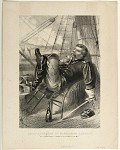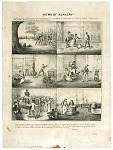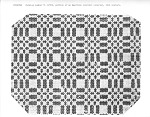unknown
Description
The tradition of shaping human likenesses on ceramic vessels is thousands of years old. Face vessels held different meanings in different cultures around the world. Some were probably used in burial rituals, others satirized the person whose features were captured in clay, and still others were made just for fun.The earliest face vessels known to have been produced by white southern potters were probably not made until the end of the 1800s. White potters working in the Edgefield area in the mid-1800s may have seen the slave-made vessels and taken the idea with them as they moved out of South Carolina.By the 1890s, southern potters began experimenting with commercially developed glazes like that seen on this piece. Pre-made glazes were easier to use and offered a wider range of colors. The maker of this piece is unknown.This face vessel, second from the right, came to the Museum as part of the Van Alstyne Collection of American Folk Art. Eleanor and Mabel Van Alstyne collected more than 300 examples of American folk art over a period of about 40 years.Currently not on view
Ceramic, Stoneware, Coarse (Overall Material)Corncob (Overall Material)
The Eleanor and Mabel Van Alstyne Collection of American Folk Art
















